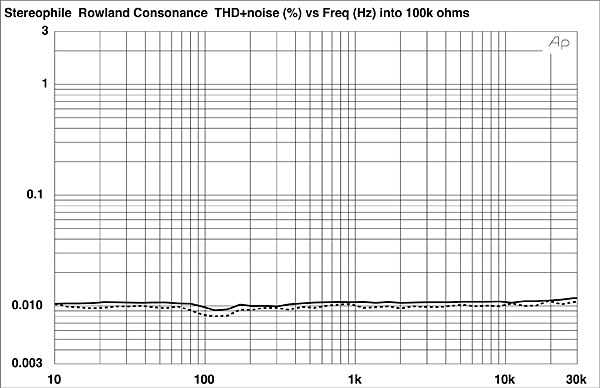| Columns Retired Columns & Blogs |
Jeff Rowland Design Group Consonance preamplifier Measurements
Sidebar 2: Measurements
The frequency response of the Consonance is shown in fig.1, which speaks for itself, as does the THD+noise curve shown in fig.2, except to note that the latter reading was almost entirely noise. The line stage was non-inverting from the "Normal" main and tape outputs with the "Phase" indicator extinguished, though the balanced XLR outputs were wired with pin 3 "hot," conforming to the older US usage rather than the IEC standard, which means that connecting it to an amplifier wired with pin 2 "hot" will invert signal polarity. The phono stage was a mystery: while it inverted the signal appearing at the tape outputs, the phono signal taken from the "Normal" outputs was polarity-correct. Apparently, the phono stage does invert absolute phase, which is why the inverted signal appears at the tape outputs; when the phono input (1) is selected, however, the preamp's microprocessor flips the output stage's final polarity to ensure that the phono signal appears with the correct polarity. Tricky stuff, this absolute phase!

Fig.1 Jeff Rowland Design Group Consonance, frequency response with volume control set to "100" at 775mV input into: 100k ohms (right channel dashed) (0.5dB/vertical div.).

Fig.2 Jeff Rowland Design Group Consonance, distortion (%) vs frequency at 1V input into 100k ohms (right channel dashed).
The line-level stage crosstalk shown in fig.3 indicates a level-dependent crosstalk characteristic. (The "T" indicates that the Audio Precision System One was unable to get a precise reading at that frequency due to noise.) It's a bit high at the maximum (200) setting of the volume control, but considerably better at lower levels, indicating that it occurs before the volume control circuitry, perhaps across the input selection circuitry. From the way it rises with frequency, the crosstalk appears to be mainly capacitive coupling between the channels. The typical volume settings I have used with the Consonance with other equipment of average sensitivity almost never exceeded 120—the level used for the mid-level crosstalk measurement.

Fig.3 Jeff Rowland Design Group Consonance, channel separation L–R with (top to bottom): 100mV input, volume control at"200"; 500mV, v/c at "120"; and 1V input, v/c at "78."
Fig.4 shows the Rowland's RIAA equalization error, measured with gain set for moving-coil; it falls within spec. It's interesting to compare this measurement with that of the Audio Research SP-14 (fig.5). The slight rise in the latter's response across the treble, combined with the Rowland's minor dip there, could account for the somewhat livelier sound of the Audio Research (a difference of about 0.5dB over a broad range). There's about a dB of difference (in favor of the Rowland) in the low bass. The relative differences between the curves do not explain all of my observations, however, which was not a surprise.

Fig.4 Jeff Rowland Design Group Consonance, RIAA error, 500µV input at 1kHz input (right channel dashed, 0.5dB/vertical div.).

Fig.5 Audio Reseach SP-14, RIAA error, 500µV input at 1kHz input (right channel dashed, 0.5dB/vertical div.).
Other measurements indicated that the unity gain setting of the Rowland falls at a setting of 78 in the balanced mode, 114 unbalanced. The balanced-line output impedance is 595/598 ohms, the unbalanced 296/299 ohms (L/R channels respectively, rounded to the nearest ohm). This was taken with the output impedance set for the factory setting, 300 ohms, which was used for most of the listening. The line input overloaded (1% THD) at an output of 21.5V (volume control at 200) and 17.4V (volume control at 100). Overload margin on the moving-coil input (again, for 1% THD) referred to 500;uV, with the appropriate emphasis, and measured at the tape outputs, was very good to excellent and consistent across the frequency range: 29.8dB at 20Hz, 30dB at 1kHz, and 30.5dB at 20kHz. Moving-coil input crosstalk at 1kHz was in excess of 55dB, and DC offset was negligible on all outputs.—Thomas J. Norton
- Log in or register to post comments




































